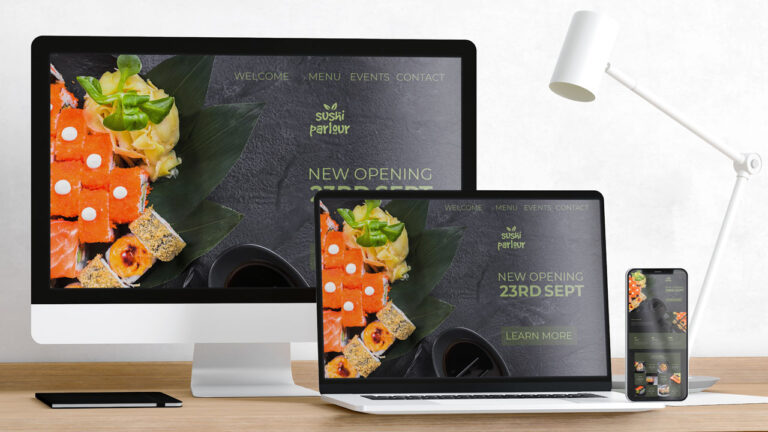
Tailwind CSS makes it easier than ever to ensure websites look great and function seamlessly across all devices in today’s digital age. With users accessing the web from various screen sizes— from smartphones to large desktop monitors—responsive design has become a necessity rather than a choice.
Table of Contents
Tailwind CSS, a utility-first CSS framework, offers a powerful and efficient way to create responsive websites without writing complex custom CSS. Using Tailwind’s ready-made utility classes, developers can quickly adjust layouts, typography, and elements to fit different screen sizes, ensuring that their websites are visually appealing and highly functional. In this blog, we’ll explore how Tailwind CSS simplifies the process of building responsive websites, making it an ideal choice for developers who want to deliver a polished user experience on any device.
Setting Up Tailwind CSS for Your Project

Getting started with Tailwind CSS is straightforward, making it a popular choice for developers who want to create responsive designs quickly. You’ll first need to set up Tailwind in your project. If you’re working with a new or existing project, there are two main ways to integrate Tailwind: using a CDN or npm for more advanced configuration.
Using the CDN
For beginners or quick prototyping, you can link Tailwind directly into your HTML file using a CDN. This is the simplest way to start experimenting with Tailwind’s utility classes without a complex setup:htmlCopy code
Copy code
<link href="https://cdn.jsdelivr.net/npm/tailwindcss@latest/dist/tailwind.min.css" rel="stylesheet">Installing via npm
For more control and scalability, installing Tailwind through npm is recommended. This method allows you to customize configurations, optimize performance, and benefit from future updates:
First, initialize npm in your project: Copy code -> npm init -yNext, install Tailwind CSS: Copy code -> npm install -D tailwindcssCreate a configuration file: Copy code -> npx tailwindcss initThis configuration file allows you to define your custom styles and responsive breakpoints. With Tailwind’s extensive documentation and community support, you’ll find it easy to tailor the framework to meet your project’s needs.
Understanding Responsive Design with Tailwind CSS
Responsive design ensures your website looks great and functions well on devices of all sizes, from mobile phones to large desktop monitors. Tailwind CSS makes this process incredibly simple by using a mobile-first approach and providing a wide range of utility classes that target different screen sizes.
In Tailwind, responsive breakpoints are built directly into its utility classes. By default, Tailwind includes these breakpoints:
smfor small devices (min-width: 640px)mdfor medium devices (min-width: 768px)lgfor large devices (min-width: 1024px)xlfor extra-large devices (min-width: 1280px)2xlfor larger screens (min-width: 1536px)
You can use these breakpoints to create responsive designs effortlessly. For example, if you want to change the text alignment on different screen sizes, Tailwind makes it easy with responsive classes:
Copy Code
<p class="text-center sm:text-left md:text-right"> This text will be center-aligned on mobile, left-aligned on small screens, and right-aligned on medium screens. </p>By simply adding responsive prefixes like sm:, md:, and lg:, you can easily control how your design adapts across different devices. This approach eliminates the need for complex media queries and gives you fine-grained control over your website’s layout.
Tailwind’s responsive utilities ensure that your site not only looks great on mobile but also scales perfectly as screen sizes increase, providing a consistent user experience across all devices.
Creating Responsive Layouts with Tailwind’s Flexbox and Grid Utilities
One of Tailwind CSS’s greatest strengths lies in its ability to handle complex layouts easily using Flexbox and Grid utilities. These tools are essential for creating responsive designs that adapt seamlessly across various screen sizes.
Using Flexbox for Responsive Layouts
Tailwind simplifies the process of building flexible layouts with its Flexbox utility classes. To create a basic responsive layout, you can start by defining the container as a flexbox:
<div class="flex flex-col md:flex-row">
<div class="flex-1">Column 1</div>
<div class="flex-1">Column 2</div>
</div>In this example, the layout stacks vertically (flex-col) on smaller screens and switches to a horizontal layout (flex-row) on medium screens and above (md:flex-row). By using Tailwind’s responsive utility classes, you can ensure that the layout automatically adapts to the screen size without writing custom CSS.
Using Grid for Complex Layouts
Tailwind’s Grid utilities provide even more flexibility when dealing with complex layouts. You can create grid-based designs that adjust dynamically across different devices:
<div class="grid grid-cols-1 sm:grid-cols-2 lg:grid-cols-4 gap-4">
<div>Item 1</div>
<div>Item 2</div>
<div>Item 3</div>
<div>Item 4</div>
</div>In this example, the grid layout starts as a single column on small screens switches to two columns on medium screens, and becomes a four-column layout on large screens. The gap-4 class adds spacing between the grid items, ensuring that the design remains clean and structured.
Tailwind’s utility-first approach allows you to build responsive layouts with minimal code, keeping your design process efficient and easy to manage.
Responsive Typography and Spacing with Tailwind CSS
When building responsive websites, adjusting typography and spacing for different screen sizes is crucial. Tailwind CSS offers a range of utility classes that make this process effortless, allowing you to scale your font sizes, padding, margins, and other spacing properties dynamically.
Responsive Typography
Tailwind provides a set of predefined font size utilities that can be adjusted based on the screen size. For example, you can make text larger on larger screens while keeping it readable on smaller devices by using Tailwind’s responsive classes:
<h1 class="text-2xl sm:text-3xl md:text-4xl lg:text-5xl">Responsive Heading</h1>In this example, the heading will display as text-2xl on smaller screens, text-3xl on small devices, text-4xl on medium screens, and text-5xl on larger screens. This gives you precise control over how typography scales across different devices, ensuring your website is readable and visually appealing.
Responsive Spacing
Tailwind also makes it easy to adjust spacing like padding and margins for different screen sizes. You can use responsive classes to create flexible designs that adapt to different layouts without extra CSS:
<div class="p-4 md:p-8 lg:p-12">
This container has different padding for small, medium, and large screens.
</div>In this example, the container will have p-4 (16px padding) on smaller screens, p-8 (32px) on medium screens, and p-12 (48px) on large screens. Tailwind’s spacing utilities help maintain consistent design while allowing flexibility for various screen sizes.
By using Tailwind’s responsive typography and spacing utilities, you can ensure your content remains easy to read and visually appealing across all devices, improving both user experience and design consistency.
Tailwind’s Mobile-First Approach and Why It Matters
Tailwind CSS follows a mobile-first approach by default, meaning the design starts with styles optimized for mobile devices, and then progressively adapts to larger screen sizes. This method ensures that the most crucial user experience, which typically occurs on smaller devices, is prioritized from the beginning.
What Is Mobile-First Design?
Mobile-first design is a development strategy where the design and layout are first crafted for smaller screens (like smartphones), and then enhanced as screen sizes increase. This approach ensures that the website is lightweight, fast, and fully functional on mobile devices, which is where a significant portion of web traffic originates today.
With Tailwind, the mobile-first workflow is seamless. By default, utility classes apply to mobile devices, and you can progressively modify them for larger screens using responsive breakpoints. For example, let’s say you want an element to have full width on mobile but half-width on larger screens:
<div class="w-full md:w-1/2">
Responsive Width
</div>In this example, the width is set to 100% (w-full) for mobile devices and medium-sized screens (md:), it switches to 50% (w-1/2). This mobile-first methodology ensures your design scales efficiently without bloating your code.
Why Is Mobile-First Important?
The mobile-first design ensures that your website performs optimally on the smallest devices first. As users continue to rely more on mobile phones for web browsing, this approach guarantees that your website is fast, functional, and user-friendly, especially in low-bandwidth situations. With Tailwind’s built-in mobile-first philosophy, creating responsive and accessible websites becomes second nature, saving time and effort while delivering an exceptional user experience.
Using Tailwind Plugins for Enhanced Responsiveness
Tailwind CSS offers a variety of plugins that extend its functionality, allowing you to implement more complex and responsive features without writing custom CSS. These plugins are especially useful when working on advanced responsive designs or adding specific behaviors to your website.
Aspect Ratio Plugin
When building responsive websites, maintaining consistent aspect ratios for images or videos can be challenging. Tailwind’s @tailwindcss/aspect-ratio plugin solves this issue by giving you control over element ratios without manually calculating the CSS:
<div class="aspect-w-16 aspect-h-9">
<img src="image.jpg" alt="Responsive Image" />
</div>In this example, the image will always maintain a 16:9 aspect ratio, ensuring it looks good on any device, from mobile phones to large desktop screens. This plugin is especially handy when embedding videos or designing galleries.
Forms Plugin
Forms are a key part of any website, and ensuring they are responsive and accessible is important. Tailwind’s @tailwindcss/forms plugin simplifies the process by providing form element styles that adapt well across different devices:
<form class="space-y-4">
<input type="text" class="block w-full p-2 border" placeholder="Enter your name">
<button class="bg-blue-500 text-white p-2 rounded">Submit</button>
</form>With just a few utility classes, you can create clean, responsive forms that work well on both mobile and desktop screens. The plugin ensures consistent form styling without extra CSS overhead.
Typography Plugin
When it comes to making text responsive, the @tailwindcss/typography plugin is another valuable tool. This plugin provides pre-defined styles for content-rich pages, making typography look professional across all screen sizes:
<article class="prose lg:prose-xl">
<h1>Responsive Typography with Tailwind CSS</h1>
<p>This is a block of text that adjusts beautifully for different screen sizes</p>
</article>The plugin ensures that text scales appropriately maintains readability, and stays consistent, especially on larger screens.
By leveraging Tailwind’s plugins, you can enhance responsiveness and functionality, all while keeping your codebase clean and manageable.
Conclusion:
Tailwind CSS provides an efficient, flexible, and highly customizable approach to building responsive websites. With its utility-first philosophy, developers can focus on functionality and user experience without getting bogged down by complex custom CSS. Whether you’re creating simple layouts or more complex, responsive designs using Flexbox and Grid, Tailwind’s utility classes make it easy to adapt your website to any screen size.
The mobile-first approach ensures that your website performs optimally on all devices, starting with the smallest screens. Tailwind’s built-in responsive utilities, combined with its powerful plugins, offer an unparalleled development experience, allowing you to create visually appealing and user-friendly websites that scale beautifully across devices.
By mastering Tailwind CSS, you’ll not only streamline your workflow but also ensure that your web projects are both modern and fully responsive—meeting the demands of today’s diverse user base.

 Exclusive Offer Alert!
Exclusive Offer Alert!
 Get 10% OFF on Every Product!
Get 10% OFF on Every Product!


 Use Coupon Code:
Use Coupon Code:
 Shop Now & Save More!
Shop Now & Save More!


